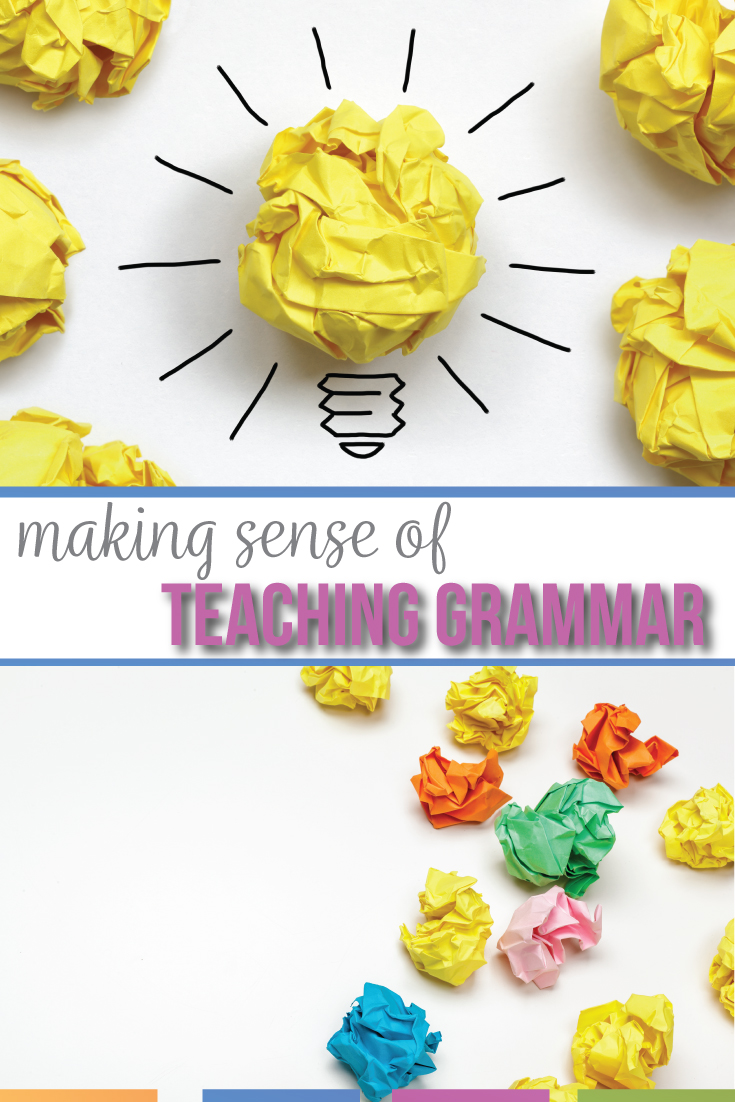Grammar must be taught. How we teachers cover grammar, that is the difference.
If you are an ELA teacher on social media, you’ve likely seen the meme that quotes this page from NCTE, the one that references grammar as a skunk in the garden party of ELA. The grammar controversy is not new, but teachers and organizations can wield it negtively.
Well.
I personally understand literature and nonfiction through grammatical elements, and I’ve seen students enjoy language arts from a grammatical lens. I naturally rely on grammar when I read a complex sentence or question a political speech. Grammar instruction does improve writing when teachers understand how to implement grammar lessons. It is offensive to students who understand your language arts class through grammatical learning to call grammar a skunk. Since some students enjoy grammar lessons and understand ELA through a grammatical point of view, it is largely insulting to tell those students that grammar instruction is bad.
So, why should we teach grammar? Some students simply understand components of your class better because they understand grammar.
Secondly, it’s unfortunate that while English teachers rarely shy away from teaching domain-specific vocabulary such as symbol, malapropism, and theme with literature; claim, thesis, and conclusion with writing; and target audience, transitory statement, and closure with public speaking, many recoil at dependent clause, participial phrase, or dangling modifier.
We teachers need to talk about grammar as we do writing, literature, and public speaking… as math teachers use domain-specific language. Teachers can study how our language works. Best practices for teaching grammar include using domain-specific language.
Finally, all offensive animal references aside, I want to explore why this quote circulates through social media. Why do some teachers dislike grammar? Why should we teaching grammar. Also, what are best practices for teaching grammar?
I have ideas on the subject, and they require a historical perspective.

Past
The Braddock report came out in the 1963. Bloggers and writers still quote this report from over fifty years ago. Overall, the report concludes that the teaching of grammar is harmful to student writing.
For those who may not know, the Braddock study’s (famously) quoted lines are:
The conclusion [of this review] can be stated in strong and unqualified terms: the teaching of formal grammar has a negligible, or because it usually displaces some instruction and practice in actual composition, even a harmful effect on the improvement of writing.
Researchers and writers parse pieces of this study. Beliefs about grammar is a spectrum. Most writing about grammar will reference the Braddock study and some teachers will reference this study as to why they should avoid grammar instruction. English teachers don’t agree about it though. Consider:
- David Mulroy condemns the Braddock study in The War Against Grammar. Mulroy emphasizes that the Braddock’s study cannot be duplicated. He also ties a lack of grammar studies to lower SAT scores and decreased reading comprehension.
- Trygve Thoreson found improvement in student writing with grammar instruction.
- Other researchers such as Hannah Patriquin stress that grammar instruction should make sense, and that it simply should not be a regurgitation of rules.
- Finally, NCTE states:
Knowing about grammar also helps us understand what makes sentences and paragraphs clear and interesting and precise. Grammar can be part of literature discussions, when we and our students closely read the sentences in poetry and stories.
Yikes. Grammar instruction is complex. What should teachers do, and what are best practices for teaching grammar?
Past connected to the future
First, don’t assume that grammar benefits only writing.
The first problem with this conclusion is the assumption that grammar is only taught to better writing. Understanding grammar provides benefits unrelated to writing.
The second problem is that the Braddock research is flawed. In The War Against Grammar, David Mulroy highlights the problem with this study and others like it:
All of them concern the short-term effects of instruction in formal grammar on the work of relatively mature students. For this reason, these studies have no real bearing on the value of the traditional approach to teaching grammar. From antiquity to the twentieth century, grammar was introduced to children at the beginning of their schooling, as soon as they learned how to read, and it remained a central concern for several years. It was a foundation that was built carefully and gradually in the still-receptive minds of relatively young pupils. The question to be asked then is whether a foundation that was built carefully and gradually in the early grades is beneficial to students later in their academic careers. Instead of addressing that question, the research projects cited by Braddock and by Hillocks ask what happens when you insert some grammar into the curriculum at various spots along the way. This is like trying to insert partial foundations beneath half-finished houses and concluding from the ensuing debacles that foundations are useless. (page 75)
These reports have given teachers an incomplete view of grammar and shaped policy for decades. When the Common Core Standards came into education years ago, it was because students lacked knowledge of their language. Students should be able to talk about the language they speak and write.
So, that is a ton of information and yes, the Braddock study still influences how teachers consider grammar today. When thinking of grammar, consider more than that one study. (You can read the study online.) It deals with writing, but NCTE encourages teachers to apply grammatical knowledge to more than writing.
When a colleague questions teaching grammar because of the Braddock study from 1963, take some time to research the spectrum of beliefs about grammar. The situation is not simple.

Present
Grammar has returned to the classroom, but some teachers still find it harmful and are reluctant to teach it. Aside from a report done fifty years ago, why? I suspect three large reasons.
1. Experience
One, compared to other parts of the content, teachers may have never experienced strong grammar lessons as pupils. Consider memorable ELA lessons that shaped you as a student. For instance when I was in high school, my ELA teacher wore as veil as she taught “The Minister’s Black Veil.” Years later, I repeated that lesson because I wanted my students to feel that uncertainty, the power of that lesson.
As a young student, I never felt that with language. I never saw how a few grammar worksheets made me a better English student.
Two, teachers lack background information and the depth of research. Teacher training for language arts teachers lacks grammar and language studies.
For instance, I took one language class in college, and it was dismal. Students dreaded the course, and the professor chose a book from the 1920s. (It was out of print, and the bookstore grumbled that he would not choose a new book.) How should grammar be taught? I certainly didn’t leave that course with a better idea. In fact, I left believing that I simply knew how not to teach grammar.
Think of reading or writing classes in college. We teachers studied approaches, research, and controversies surrounding our future lessons. Teachers don’t always understand the depth of grammar like we do other content pieces.
As an example, future teachers should study about prescriptive and descriptive grammatical approaches which leads to the third reason for a lack of grammar lessons. Prescriptive grammar is the set of rules for how grammar is used. Descriptive grammar is studying how grammar is used. Who wants to teach and insult their students simultaneously? (I certainly don’t.)
And I think the culmination of those three instances (grammar’s history, uninspired grammar lessons, plus a lack of direct instruction for pre-service teachers), left teachers decades ago saying, “you know, by correcting my students’ language, I’m diminishing their culture, and maybe not even helping them.”
And now those students are teachers. Teachers who today are told that grammar must be taught.
Conflict against best practices
“I want my students to think.” Teachers fear that grammar instruction is in direct opposition to research considering best practices. We can make our grammar lessons engaging and interactive though.
I hear the concerns, and I know what teachers mean. I want my students to think too. I don’t want students to simply circle the subject or recite ideas to me. I want more too.
We give our students all sorts of tools for thinking. Consider the tools we provide students for analyzing literature. We teach literary terms, specifics of genres, characteristics of time periods, histories of authors, elements of a story, and more.
What would happen if we armed students with similar tools for studying language? When teaching grammar, teachers most certainly can have students memorize rules and lists. That’s certainly not how I teach grammar.
Understanding language arms students against fake news and biased reporting. Grammar empowers students for choosing the most impactful statement for speeches, for arranging arguments in a paper, or for developing suspense through sentence structure in a narrative. Instead, grammar is a tool for thinking, and I remind students of such.
Advance grammar lessons past rules, and you will see students analyze language with deeper meaning. When you search for best practices for teaching grammar, don’t fear you’ll only be teaching memorization. Language is deeper than that.
I did not always joyously teach grammar. I believed that I would teach senseless rules and force students into memorizing lists. Those ideas… are not true. Understanding the language we read, speak, and write allows for deeper analysis, for a greater understanding.
Other connections
Grammar isn’t a punitive task to finish within the first ten minutes of class. Instead, teaching grammar to students provides them with a lifelong tool. Too often, people assume grammar must be “taught with writing.? Why? We can easily connect grammar to other parts of class.
EDIT: As I’ve mentioned, learning grammar’s impact on student achievement is a passion of mine. My personal children are elementary students, and I read frequently about handwriting and learning cursive letters. Recent research shows that handwriting is more than a motor skill; children are interacting with their language in a meaningful way.
This has led me to question if the study of grammar is another method for younger students to interact with their language. Because reading and language is the foundation for all other learning, should we teachers provide multiple chances for students to manipulate and play with their language?
Future
We teachers have information about grammar, and we can give our students valuable grammar lessons. I humbly propose the following guidelines concerning grammar lessons.
Instead of emphasizing differences, educate students about language and don’t force outdated rules. Instead, talk about how our language changes. Grammar is a larger picture than “right and wrong.”
Realize that perhaps what you avoid in the curriculum, like grammar, might be the very reason some students come to school or enjoy language arts.
Studying language should not hurt students. It doesn’t have to, but when teachers say they don’t teach grammar, I hear them saying that they’re not willing to diminish or insult students, and they are right. Don’t return to the past where teachers insult their students and their cultures. We needn’t be the finger-wagging teacher who corrects “may” and “can.” Put the red ink pen away.
Teacher programs at universities must change. By putting these teachers at a huge disadvantage, their future students will be harmed.
I teach grammar and write about grammar. Grammar is a dynamic and growing field that benefits students. Grammar must be taught, but we must learn from our history so that our students benefit.
Looking for more? Melissa covers how she teaches grammar lessons amid the debates.
Are you looking to continue the discussion over best practices for teaching grammar? Join Grammar Gurus, my private Facebook group where teachers discuss numerous ideas, including why should we teach grammar.



